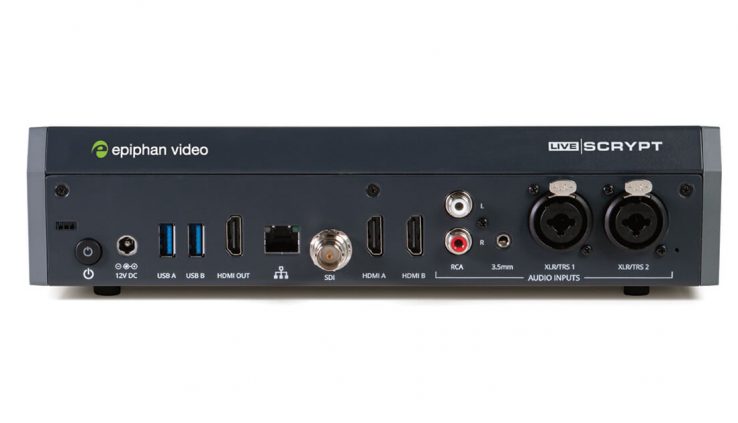Review: Epiphan LiveScrypt
By Adam Noyes
The Epiphan LiveScrypt is a largely anticipated device from Epiphan, used as a great add on to your live production. LiveScrypt comes in a similar for factor to the Pearl Mini, and combines the pros of both a hardware appliance for audio input, and a cloud application for transcriptions.
LiveScypt is a live transcription service, with a touch screen format that feeds incoming audio and multiple sources from the cloud.
Check out some highlights from this review from streamingmedia.com, below.
The hardware supports a very extensive range of audio inputs, including two XLR inputs (with Phantom power), stereo RCA connectors, a 3.5mm audio port, two HDMI ports, SDI audio, and two USB ports (see Figure 1, at top of page). Audio isn’t pass-through, so you’ll probably have to double up your outputs to support both live-streaming/local speakers and LiveScrypt. During my tests, I input audio through XLR and the RCA connectors, both of which worked well.
As mentioned, you can drive the unit locally or via the web interface. Once I paired the unit and connected a microphone via XLR, I was transcribing in seconds; the only hiccup was that I had to manually enable Phantom power to the condenser microphone in the software. You can see the result in Figure 2.

Figure 2. I was transcribing in seconds after pairing the unit in the portal.
Operationally, you start and stop transcription via controls on the upper left of the touchscreen or by using the equivalent web controls. You can see the Start button in Figure3 and the Stop button and running timecode in Figure 2. You open the controls shown in Figure 3 using one of the three buttons on the lower right.
As you can see in Figure 3, the controls are fairly simple. The System tab contains information like the IP address and serial number. Audio allows you to mute different audio inputs and set Gain levels on some, but not all, inputs.

Figure 3. The onboard controls
The Transcription tab lets you choose one of the 30 languages currently supported by the system (you can see a full list at go2sm.com/livescrypt). Currently, the system supports transcription only, so if you’re speaking German, you can output only German subtitles. However, translation is on the developmental road map. The Transcription tab also provides options to enable the automatic insertion of punctuation and a profanity filter that converts dirty words to asterisks. The Security tab lets you set a password to operate the touchscreen and the web interface.
You’ll spend most of your time in the Output tab shown in Figure 3. This is where you configure the text HDMI output from the unit for local display or input into a live-streaming system like Wirecast, shown in Figure 4. You can configure this output as text only or with text and a QR code so viewers watching a local display can retrieve the caption feed on their mobile devices.

Figure 4. Here’s the transcription inserted into Wirecast.
To capture the text in Wirecast, I connected the LiveScrypt HDMI output to an Epiphan AV.io 4K USB capture device and configured the AV.io input into the cropped box appearing at the bottom of the video input. For the record, this video was from a Sennheiser microphone review shot a few years ago, and the audio quality was quite good. I played the video file on a Mac notebook, which I input into the LiveScrypt unit via RCA connectors. At the same time, I played the same video on an HP notebook, which I input into Wirecast via Desktop Presenter. I recorded the presentation you can view with the transcription shown in Figure 4.
I was surprised that the closed-caption use case was not explicitly supported via a preset that output two or three lines in a short and wide output resolution. It’s not hard to configure the output for captions in a system like Wirecast, but it will take some experimentation to cleanly simulate closed captions. I would have thought that this use case would be so common that Epiphan would support it with a preset.
After the presentation is finished, you can download the transcription in either .srt or .txt formats from the web interface shown in Figure 5. Note that this portal contains all of the controls available on the LiveScrypt hardware itself so you can run the system remotely. On the top right of Figure 5, you can see the Stream URL that displays the transcription on the web.

Figure 5. AVStudio provides controls for the paired LiveScrypt unit and downloads of completed presentations.

